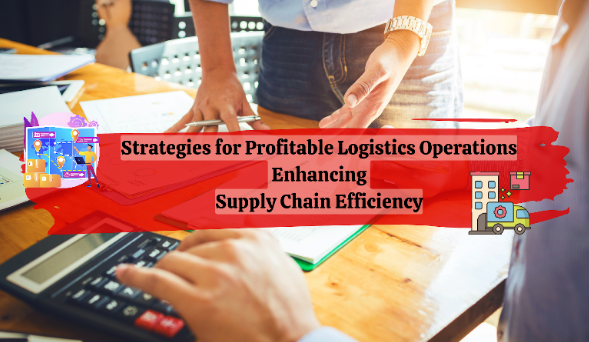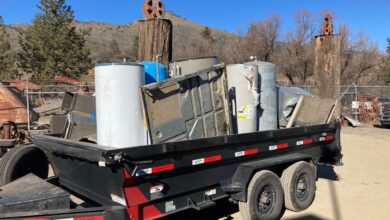Strategies for Profitable Logistics Operations Enhancing Supply Chain Efficiency

Efficient supply chain management is essential for business profitability in today’s competitive landscape. Seamless logistics operations ensure timely production and delivery of products, enhancing customer satisfaction. This article discusses key strategies for optimizing various aspects of logistics to maximize profitability and supply chain efficiency.
Streamlining Transportation
Moving products make up over 30% of total logistics costs on average. This shows that better transportation management could save companies a lot of money. Special tools now optimize driving routes to use fewer miles. These tools cut mileage by up to 20% according to Business Insider. That means major fuel savings.
Companies can also save on transport by using ships, trains, and trucks together. This “multi-modal” shipping with all three methods saves over 30% versus just trucks alone says the World Economic Forum. The different vehicles complement each other.
Another helpful change is adding technology to track transport vehicles in real-time. This visibility lets companies make sure drivers take efficient routes. Studies by McKinsey & Company show a 10-15% boost in fuel efficiency from the tracking tech.
Integrating flexible logistic automation software into transportation management is a game-changer, offering real-time tracking capabilities and enhancing overall efficiency. This technology seamlessly aligns with route optimization and multi-modal transport strategies, presenting a comprehensive solution that holds the potential for significant cost savings in the logistics industry.
Inventory Management
Inventory management costs make up a significant portion of the total logistics costs in supply chains. Warehousing extra products ties up money that could fuel company growth. Experts estimate over 25% of an item’s value gets spent yearly just to store it. So smarter inventory management matters.
Another popular tactic is the Just-In-Time model. These coordinate orders and deliveries to cut on-hand inventory by 50%. Products arrive right as needed to meet demand. This keeps storage costs far lower.
Finally, advanced data reporting now boosts inventory accuracy by up to 19%. Number crunching helps predict needs and reduce overstocking. This enables lean yet sufficient inventory in tune with purchasing trends and upcoming orders.
In total, techniques like ABC ranking, Just-In-Time supply timing, and data analysis offer big savings through tighter inventory control. Companies access exactly what’s necessary, precisely when required.
Warehouse Optimization
Warehouses make up 25% of total logistics costs on average. So making warehouses leaner and smarter helps logistics budgets a lot. Facilities can be optimized in several key ways.
First, split warehouse layouts into different storage zones based on use. Keep faster-selling items handy for quick access, while less popular products go into deeper zones. Smart zoning for order processing workflow cuts unneeded steps.
Adding warehouse automation also boosts efficiency by over 200%. Technologies like pick-to-light systems and Automated Storage and Retrieval systems speed up accurate picking. Robots can bring items to workers to assemble orders faster.
Lastly, facilities adopt Lean methodology to cut operating costs by 25%. This approach eliminates waste in processes, space, and staff time. Careful analysis helps strip out expenses not adding value for customers.
In total, zoning storage wisely, deploying robot assistants, and trimming fat through Lean thinking offer major savings. Warehouse upgrades keep inventory flowing smoothly at lower overall operational costs.
Demand Forecasting and Planning
Many companies struggle to match supply to demand. Over 60% deal with mismatches where they don’t predict needs precisely. This leads to shortages or overstocking. The problem starts with inaccurate forecasting.
Powerful new predictive analytics using AI improve forecasts by over 80% now though. Number-crunching programs factor in millions of data points with machine learning. This minimizes guessing errors on purchasing needs.
Additionally, sharing demand forecasts with suppliers smooths overall planning. Both parties can shape inventories and production levels cooperatively. This collaboration prevents the bullwhip effect. That’s when small changes amplify down the chain into big swings up or down.
In essence, modern analytics dramatically improve demand sensing. AI-powered platforms crunch market trends, seasons, events, and more for precision. Then providers and partners align supply decisions on the same page. Smoother planning means less volatility and waste.
Technology Integration
New technologies are transforming supply chain management. Programs increase visibility, communication, and efficiency at every step.
For example, advanced Transportation Management Systems now optimize truck routes. They combine loads for fewer trips and enable real-time tracking. Sensors show shipment locations and conditions continuously from pickup to delivery. This cuts costs and provides alerts if handling needs improvement.
Warehouse Management Systems also now orchestrate inventory, worker tasks, and equipment. Built-in analytics oversees operations minute-to-minute to enhance the coordination of stock and orders. Errors and delays drop significantly.
Additionally, Internet of Things sensors monitor products themselves. Tiny connected device tags travel with items down the whole chain. Companies access temperature, humidity, handling impacts, and more to safeguard quality.
In short, leading-edge systems like routing optimizers, warehouse orchestrators and sensors create transparency across suppliers, trucks, warehouses, and stores for wiser decisions. Technology drives supply chain innovation through prescriptive analytics and robust data.
Supplier Collaboration
Suppliers provide over 60% of the products that companies sell according to PwC research. So working closely with vendors saves money. New digital tools make connecting easier than ever.
For example, cloud-based supplier portals share inventory needs in real-time now. Portals facilitate just-in-time deliveries aligned tightly to production schedules. This prevents overstocking. Portals also contain dashboards, analytics, chat features, and document storage to streamline communication.
Additionally, suppliers and buyers now agree formally to share periodic demand forecasts. By understanding the changing projections together, supply variability and confusion drop.
Lastly, Supplier Relationship Management systems track vendor performance through key progress indicators or KPIs. Buyers gain visibility on production capacity, quality, pricing, and responsiveness. This allows buyers to incentivize top vendors through bigger contracts or preferred status.
In summary, digital platforms, forecast alignment, and scorecard tracking with suppliers save significant time and costs. Shared data and insights coordinate supply and demand as one ecosystem.
Risk Management
Supply chain disruptions severely hurt profits on average based on Forbes – about 11% profit erosion. Events like natural disasters, plant outages, or overloaded ports create expensive setbacks. So companies now focus more on risk management planning.
One best practice is business continuity planning.
Cross-functional teams brainstorm various disruption scenarios like warehouse technology failures or supplier bankruptcies. Then they devise responses to mitigate the impacts. This “break glass in case of emergency” playbook approach boosts resilience.
Analytics also determine ideal inventory levels as backup protection. Models weigh the costs of extra inventory with the risks and expenses of shortages to identify buffers.
Additionally, sourcing critical inputs from multiple vendors avoids reliance on a solo supplier. Some components serve as just-in-time contingency supply channels if others falter.
Real-time tracking of all supplier shipments provides disruption alerts quickly too.
Lastly, cybersecurity gets priority to safeguard data like production schedules and logistics plans. With so much supply chain connectivity now, hacking poses major threat. But investments to thwart breaches pay off.
Sustainability Initiatives
Supply chains impact the planet significantly. Transportation makes up over 15% of emissions globally says the EPA from truck exhaust alone. Additionally, packaging generates 65% of the overall supply chain’s carbon output. So sustainable practices bring huge value – both environmental and financial.
Companies now optimize routes and combine shipment loads to cut mileage for lower emissions and costs. Multi-modal transport via ship, rail, and truck balances efficiency across modes. Optimized packaging uses less material and enables reuse reducing waste.
Eco-friendly warehouses run partially on renewable power like solar and wind. Energy conservation from motion sensors and LED lighting helps too. Some facilities practice circular economy initiatives by reusing, refurbishing, and recycling onsite materials in closed loops.
According to research by BIFA, companies with greener supply chains see over 20% higher financial performance through cost and risk reductions. As stakeholder expectations rise on sustainability, planet-positive logistics provide a competitive advantage.
Frequently Asked Questions
- How can small businesses put efficient logistics strategies in place without breaking the bank?
Good news – little guys can be smart about logistics too! Tap into affordable route mapping tools, find shared warehouse spaces to split costs, and leverage flexible financing to get high-tech systems that’ll pay off down the road. Staying savvy keeps your supply chain nimble as you grow.
- What does data analytics have to do with stronger logistics?
Everything! Integrating information from delivery fleets, inventory, suppliers – you name it – creates full visibility into the flow. Advanced computing digs through the data goldmine to pinpoint friction points. Connectingintel across merchandise journeys catalyzes dynamite decisions in every corner of supply ops.
- Isn’t green logistics at odds with profits?
On the contrary – eco and economy play nice! Optimized routes cut carbon emissions from less mileage AND fatten wallet from lower fuel costs. Energy frugal warehouses powered partly by sun and wind reap savings over time too. And showcasing transparency and circular practices earns customers kudos, capturing new opportunities in the expanding sustainability space.
Final Thoughts
Mature supply chains now harness technology to run ultra-lean, clean, and precise. TMS systems continuously overhaul routing for optimal transport cost, speed, and impact. WMS platforms meticulously orchestrate resources, workers, and inventory. IoT visibility from shipment to shelf eliminates waste.
Simulation and AI prescriptively upgrade decision-making. These smart solutions optimize business health – and our shared planet’s – through both supreme efficiency gains and sustainability gains now inextricably intertwined. When supply chains sustain life, communities thrive.



